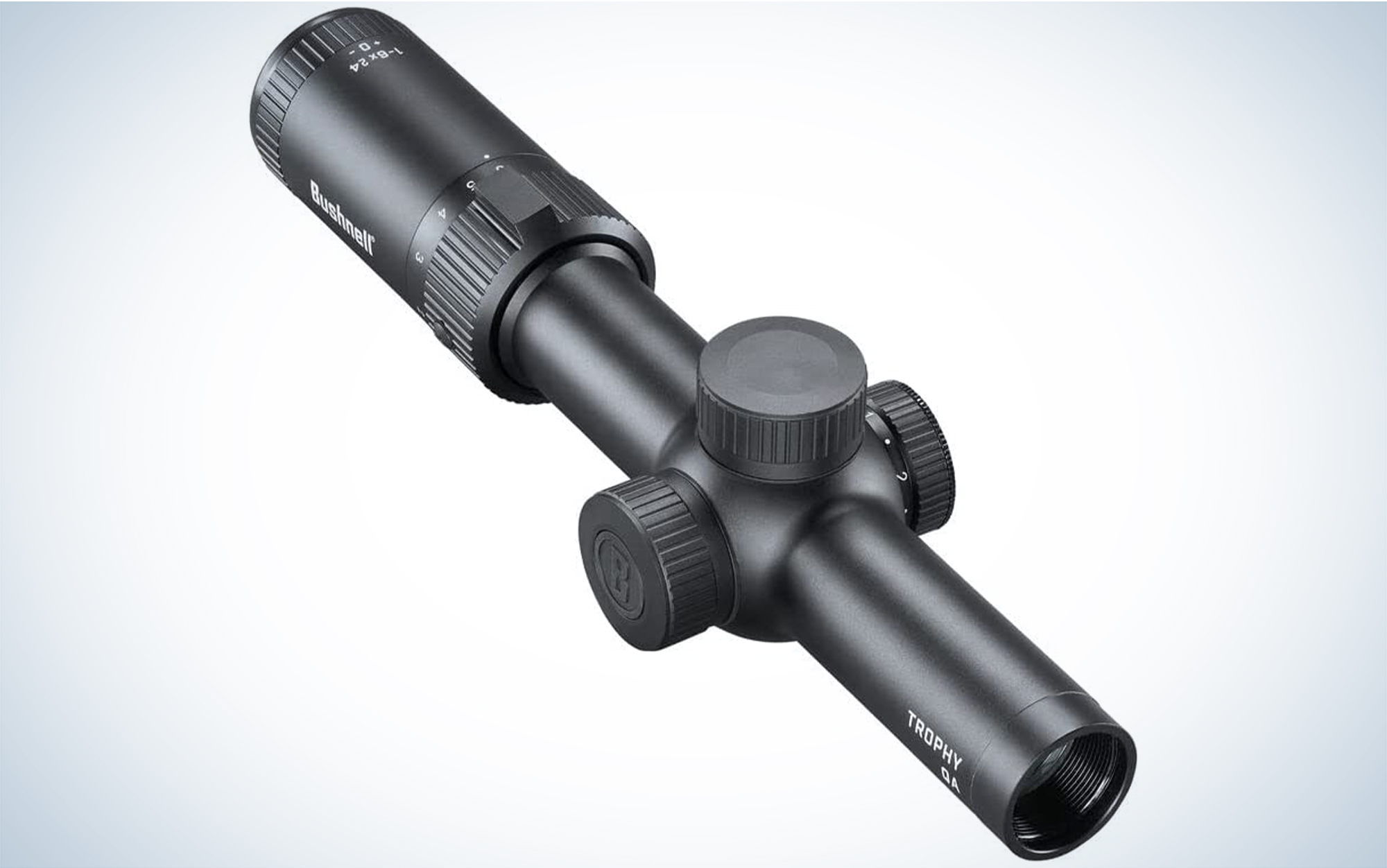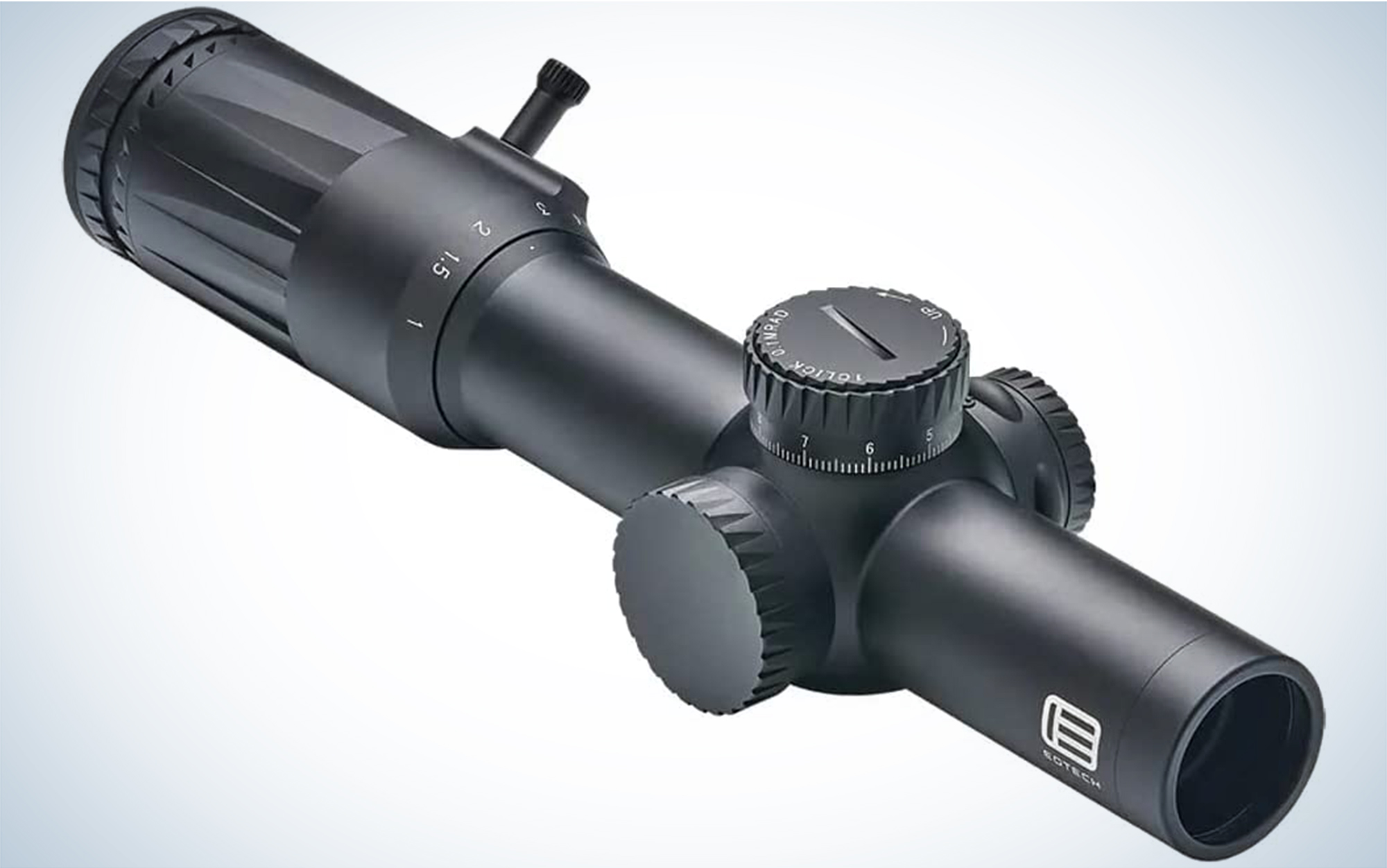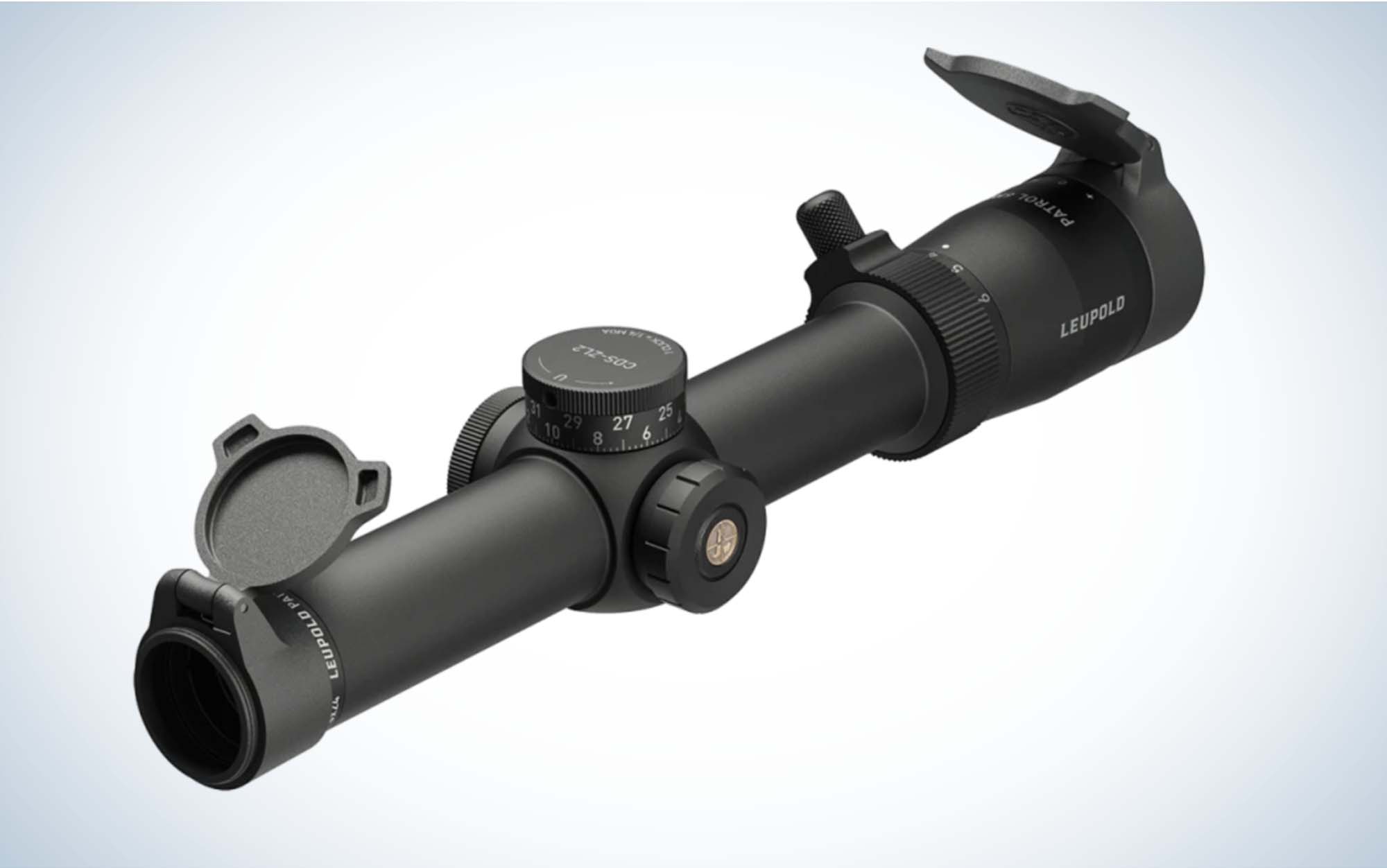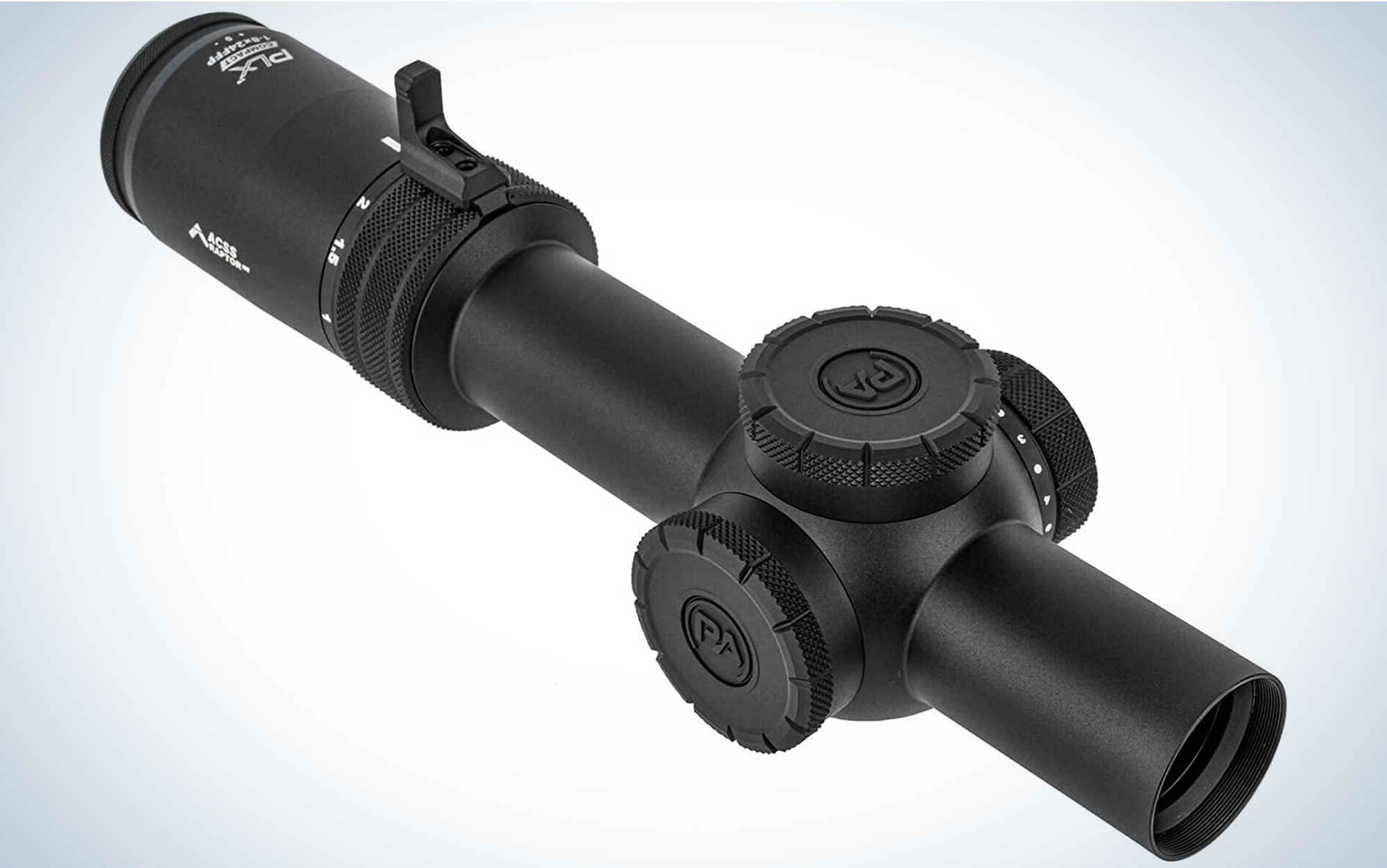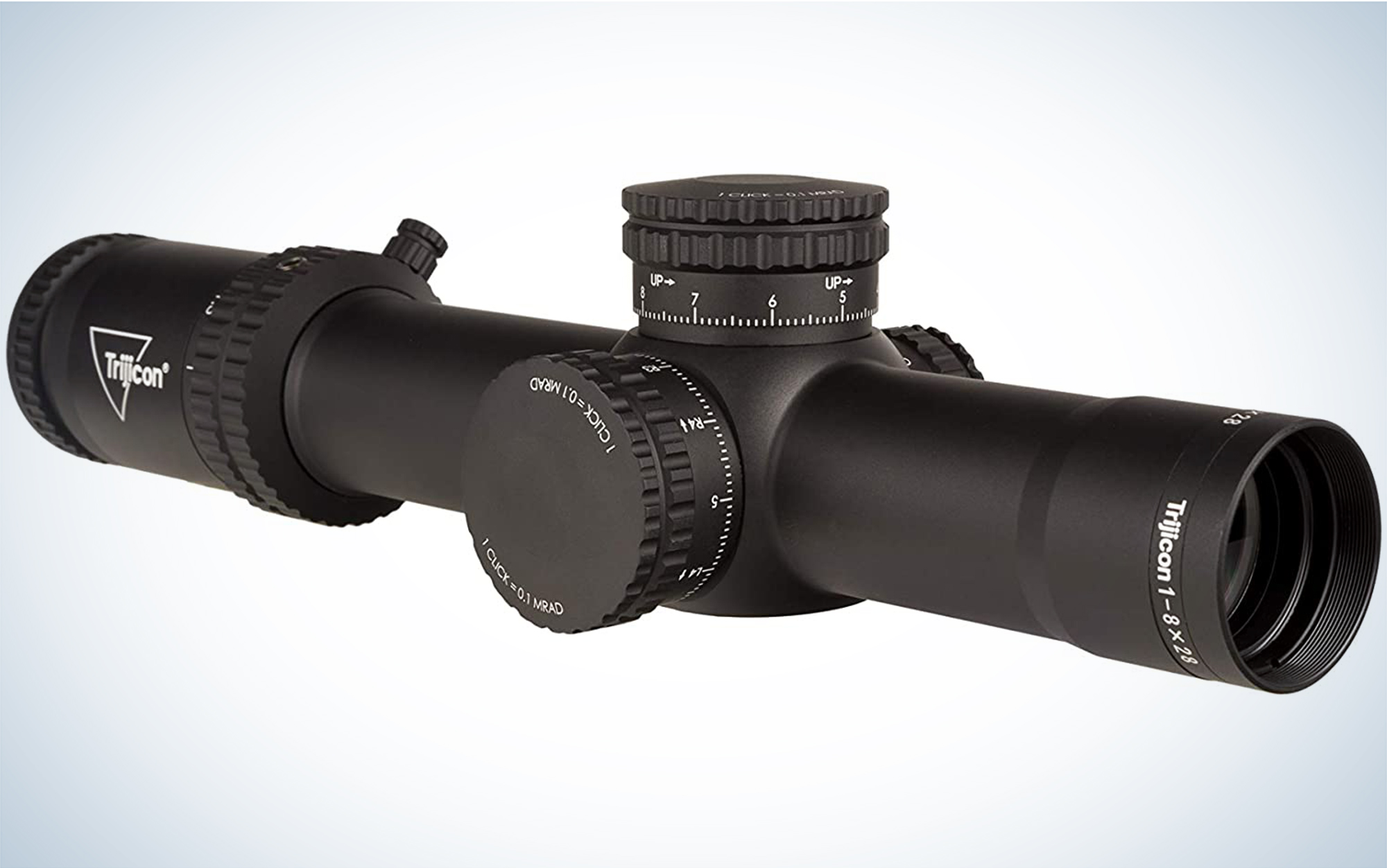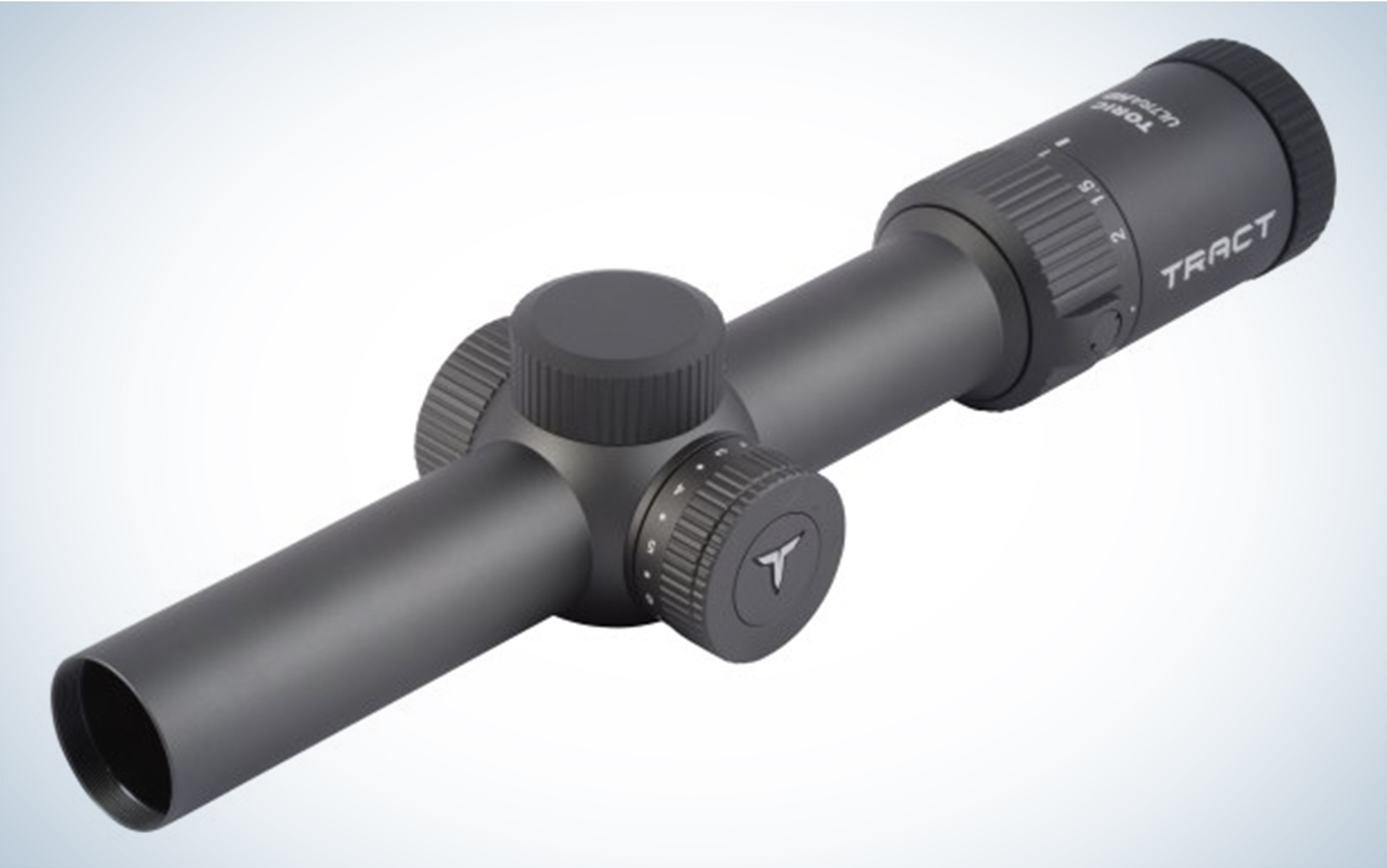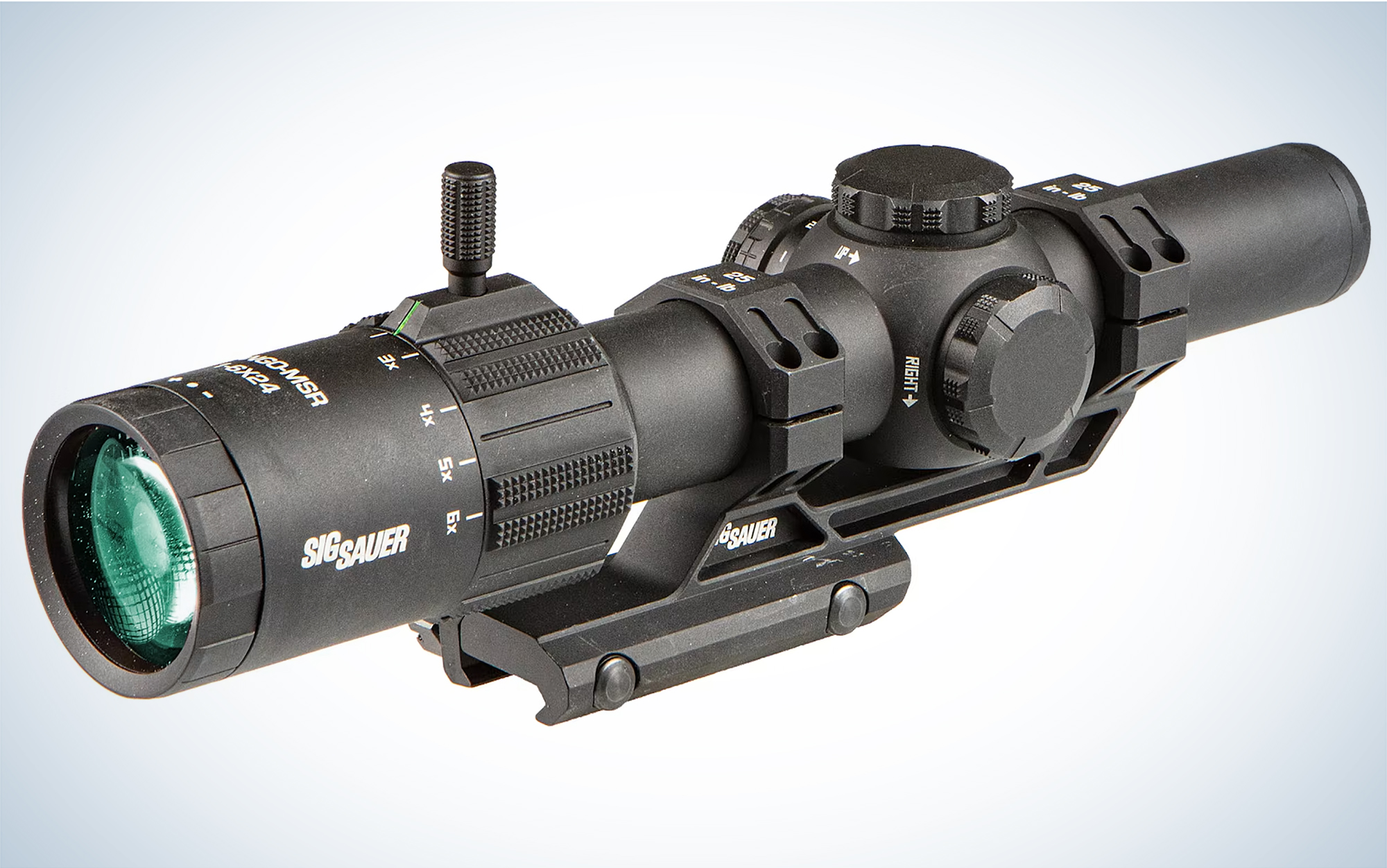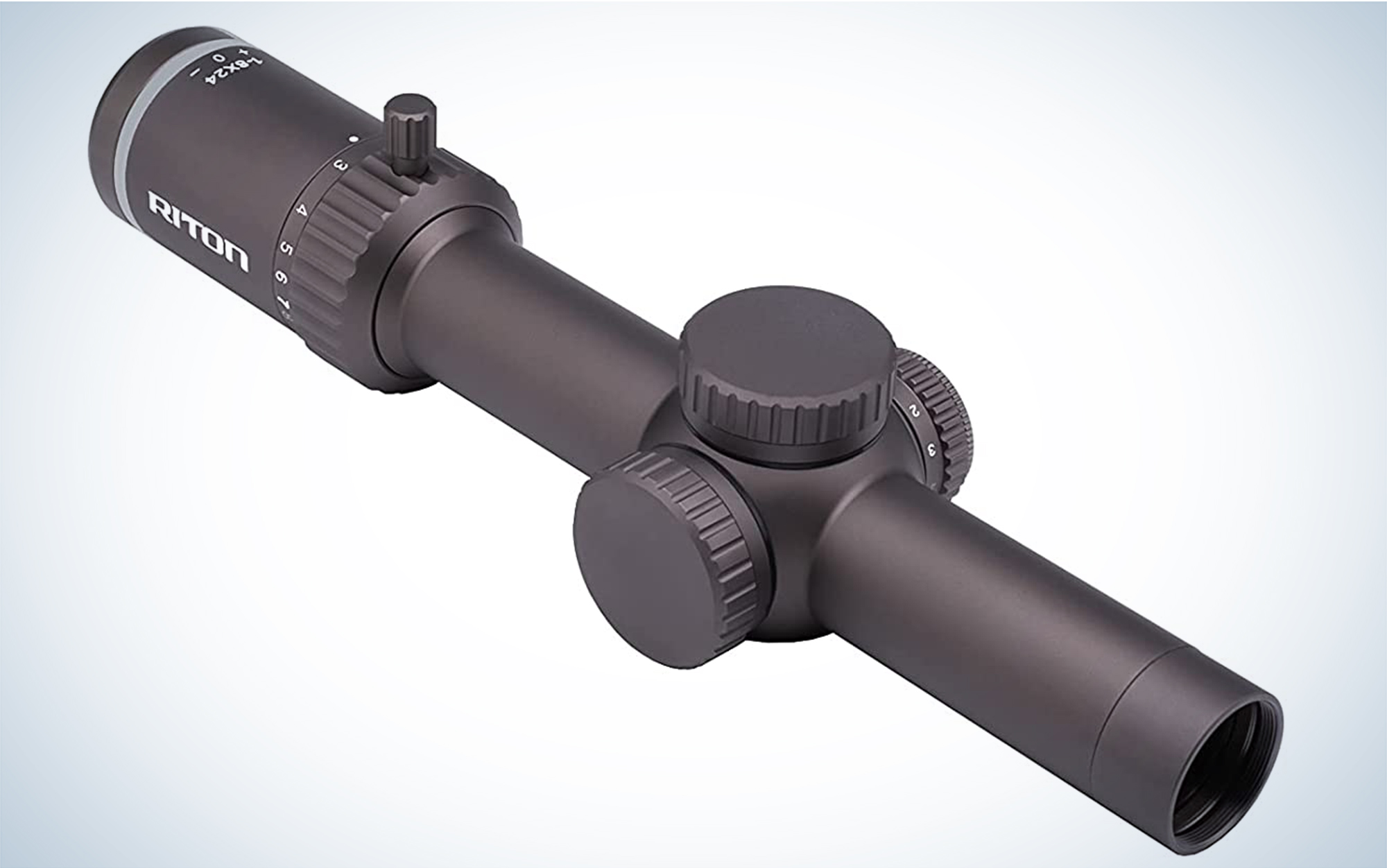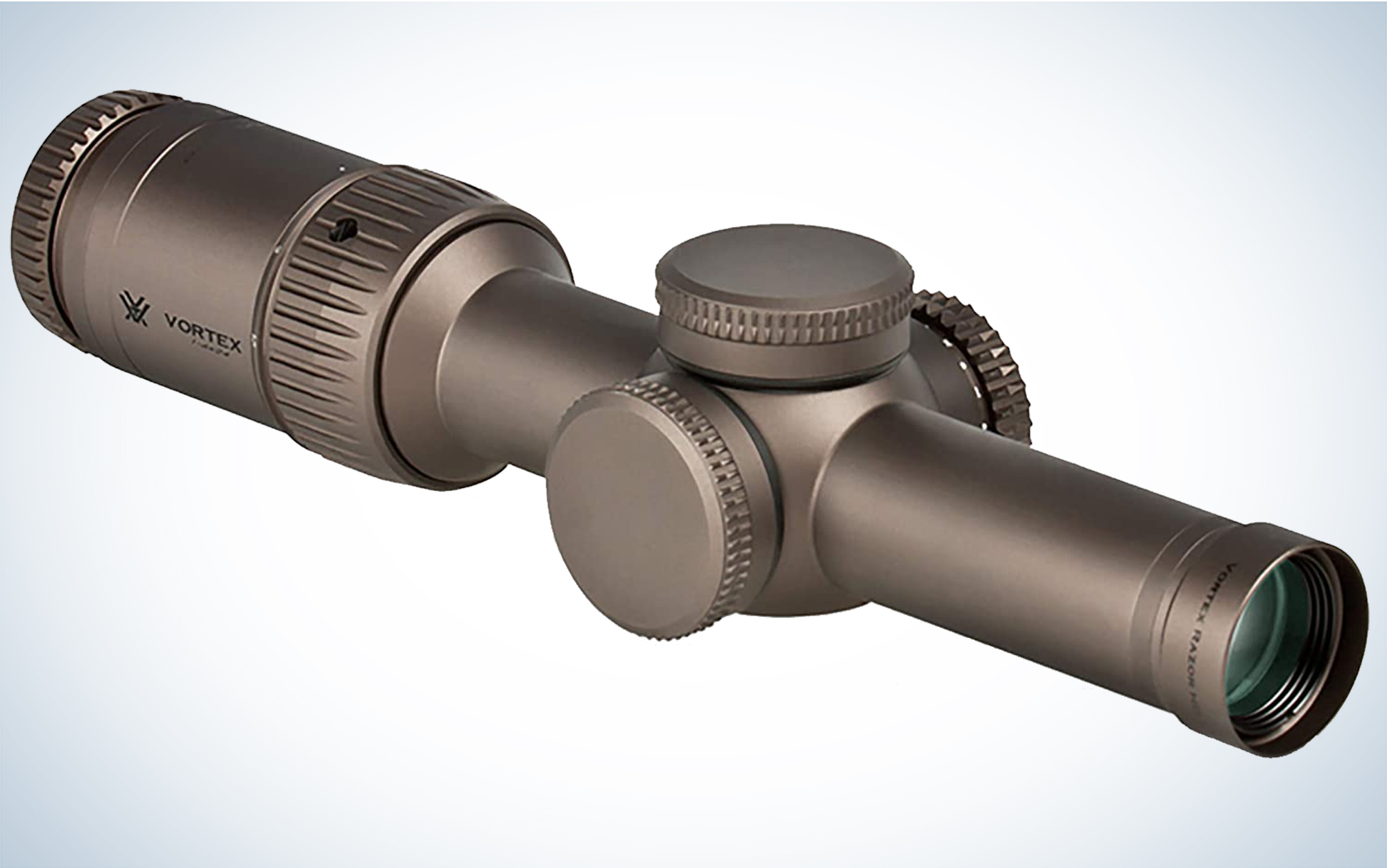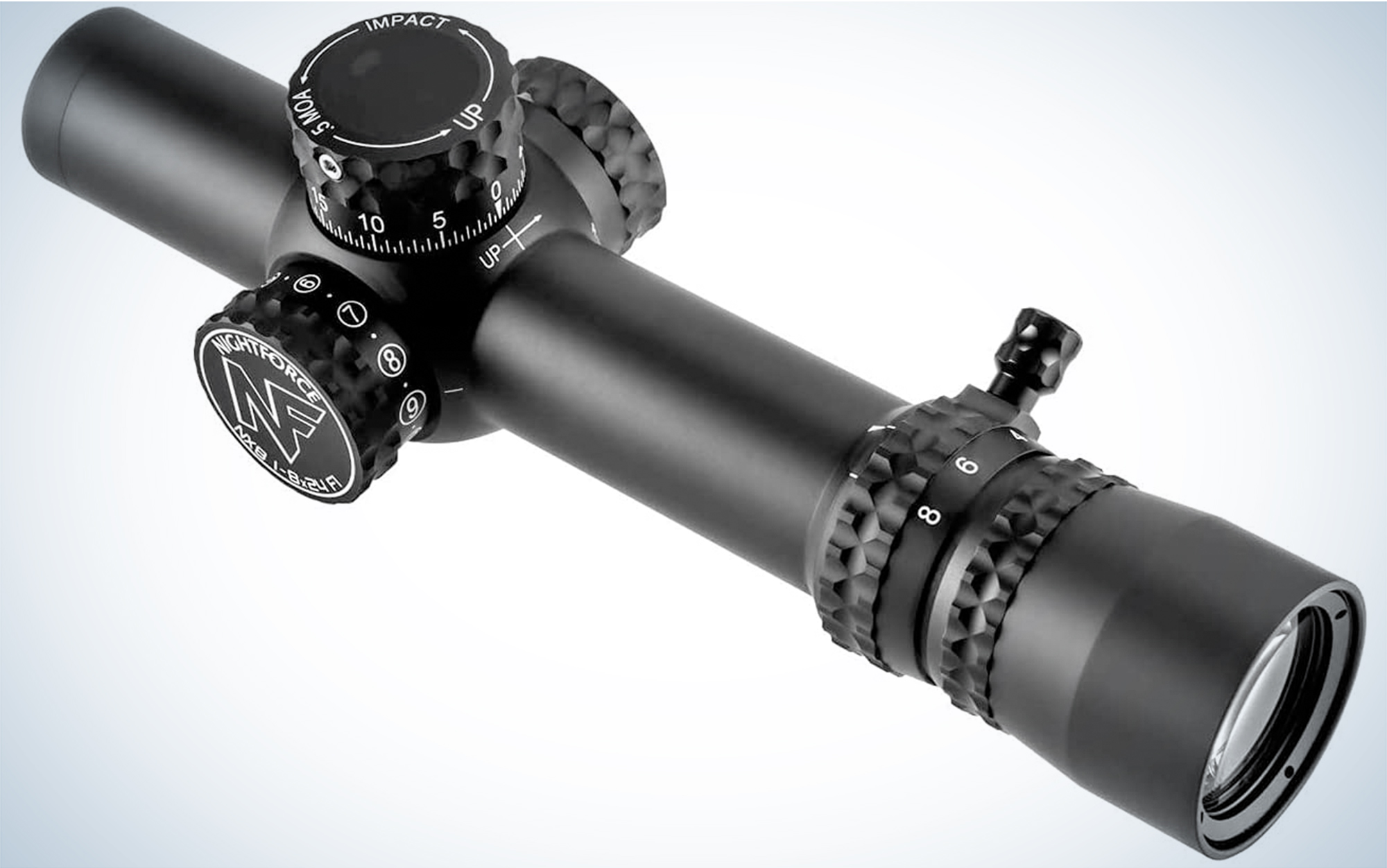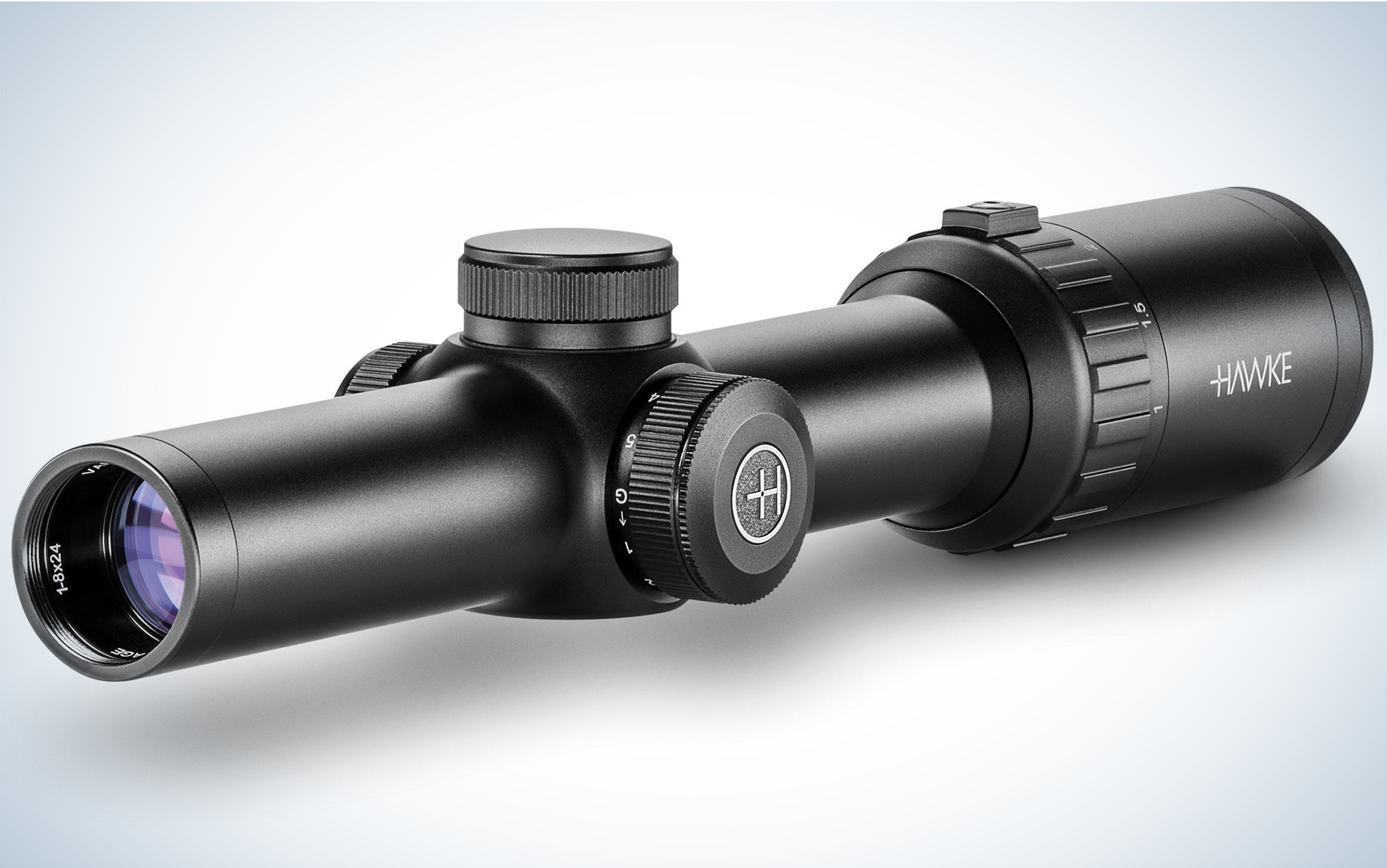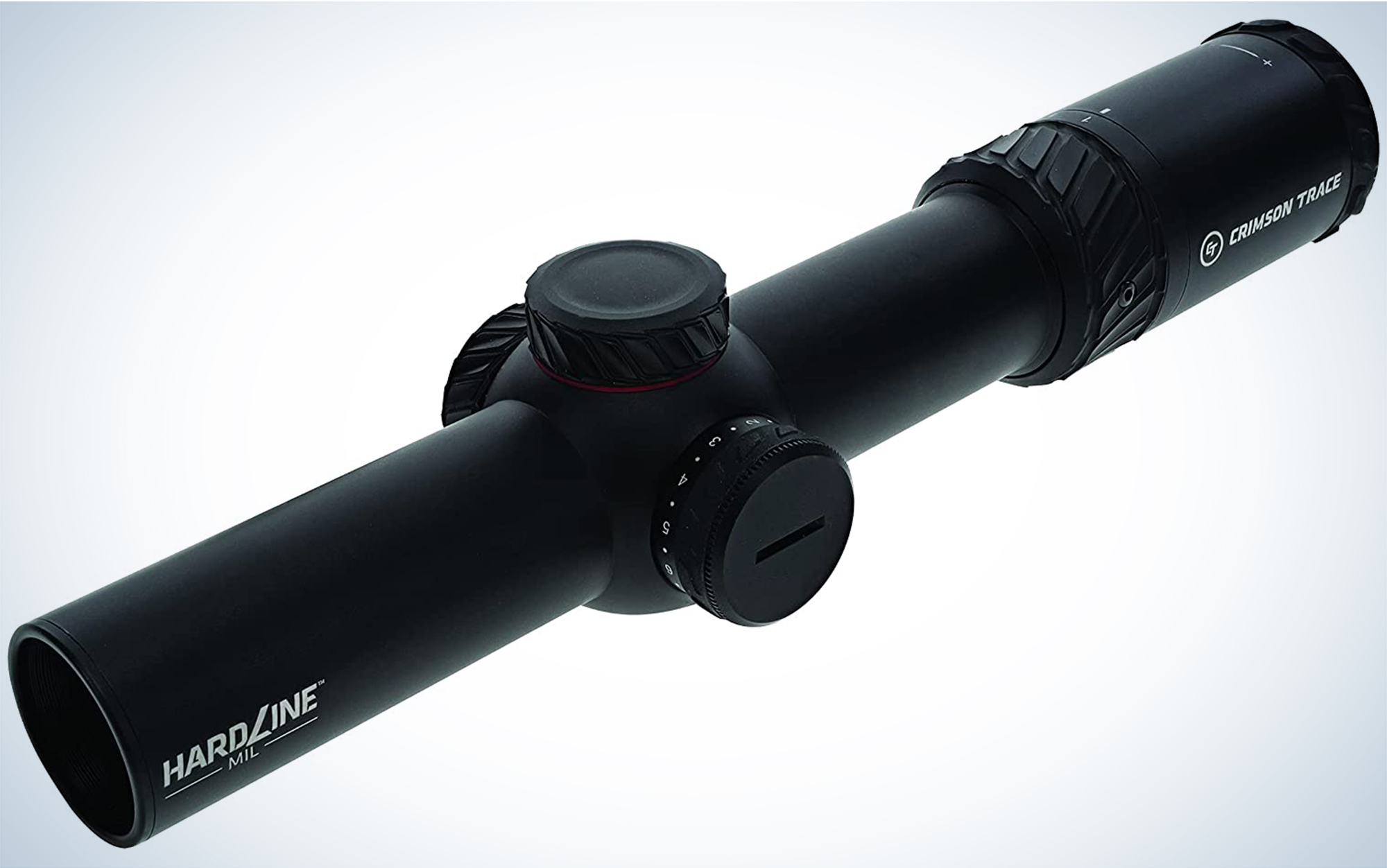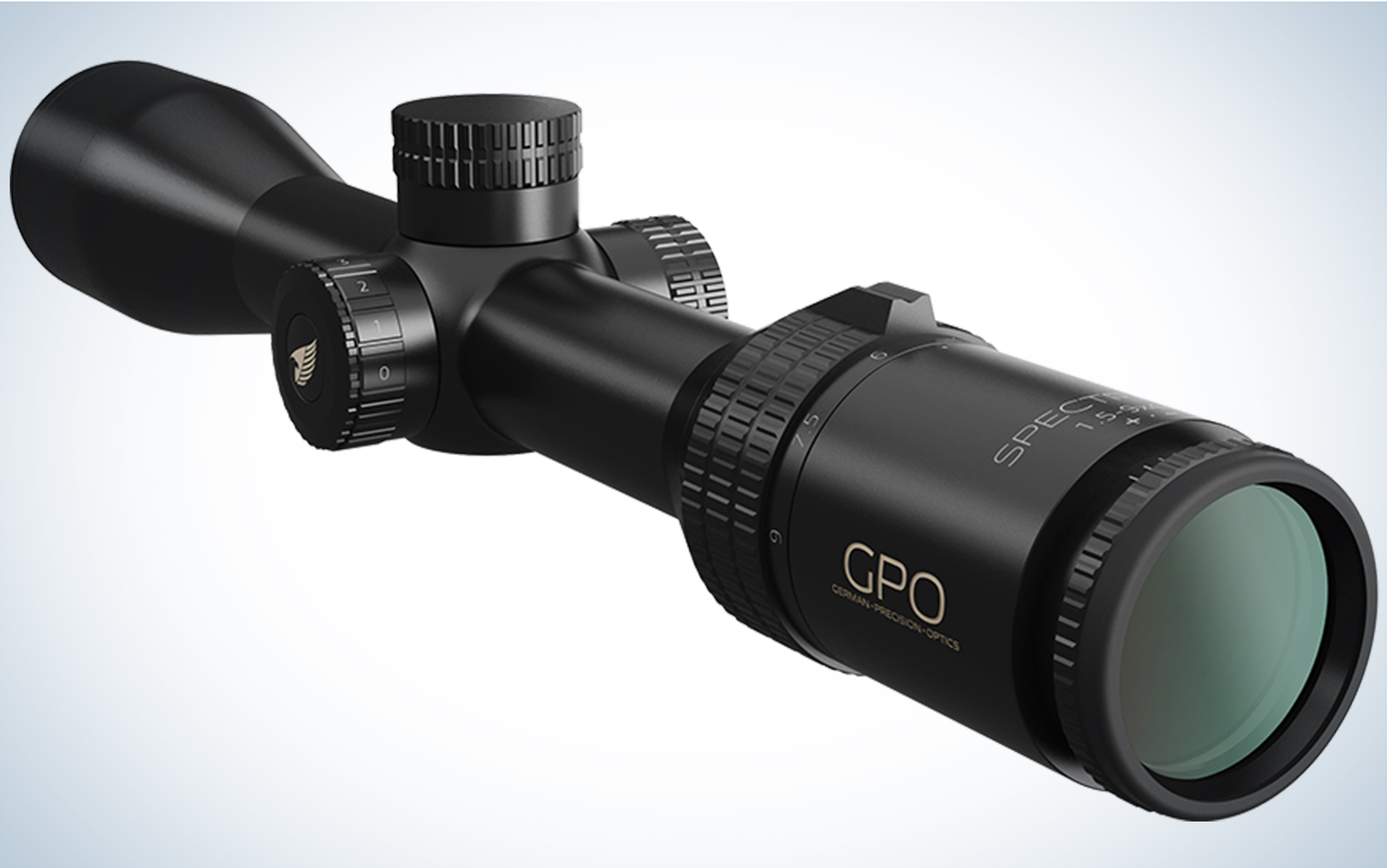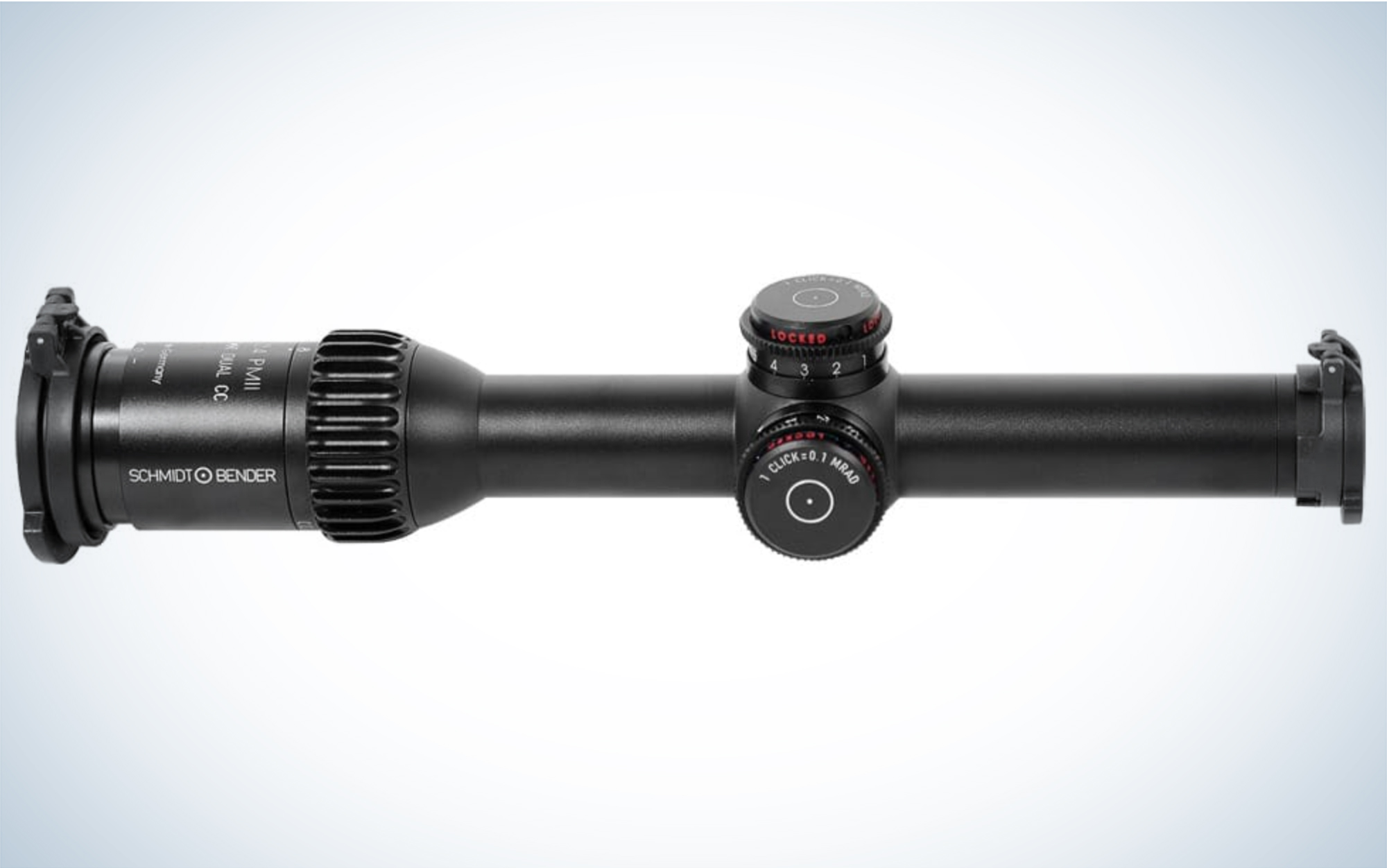We may earn revenue from the products available on this page and participate in affiliate programs. Learn More ›
Published Feb 3, 2023 11:28 AM
It’s hard to assign causality to the recent run on LPVOs, or low-power variable optics. Maybe their popularity has soared because the market for high-magnification precision scopes is saturated or because of the millions of scopeless ARs sitting in shooters’ safes.
I’d rather think the reason that LPVOs are the latest darling of shooters is more straightforward. The best of these do-everything rifle scopes are our new versatile optics, capable of performing as close-quarters red-dot scopes or, at higher magnifications, as precision aiming instruments. They can be used on a wide variety of platforms: turkey shotguns, home defense rifles, dangerous-game rifles, or squirrel plinkers. In the right hands, they can go from handling a charging bear at spitting distance to placing a round with minute-of-whitetail precision out to a half mile.
I tested several of the best LPVOs at the Outdoor Life optics test, and I’ve included my reviews of them below. I’ve also included several options that were not part of the optics test, which focused on newly released optics, but are still among the top LPVOs to consider this year.
Methodology
Most of the LPVO scopes in this article were subjected to full optics testing, which includes a battery of empirical tests and then some very subjective assessments by a panel of hunters, competitive shooters, and law enforcement personnel. We measured the optical resolution of each submission, then put each through three nights of low-light testing, measuring both reticle visibility (without illumination) and image clarity. We then mounted each sample on an AR-15 to shoot fast up close and then on a precision .22 for shooting out to 400 yards.
Each tester scored the scopes on internal and external aiming attributes, on ease of using controls, and on subjective assessments of image, reticle utility, and control positivity.
For the scopes that were not entered in the optics test, I handled each, turned their controls, and made subjective assessments of reticle design, optical capability, and durability.
Products without a “best award” are those that were not tested and evaluated in Outdoor Life’s recent optics test. Several without awards were released in early 2023 and I haven’t physically tested them.
Best Low-Power Variable Optics: Reviews & Recommendations
Best Overall: Vortex Strike Eagle 1-8×24
Key Features
- First focal plane
- EBR-8 reticle with illuminated center dot and segmented circle tuned to MOA values.
- Reticle has BDC references to 600 yards for standard .223/.308 loads
- Reticle includes an inverted ranging grid in the upper portion of the image
- Capped oversized turrets tuned to .25 MOA and 25 MOA per revolution
- 145 MOA total internal adjustment
- Nine-step illumination plus two night-vision settings
- 30mm tube
- Removable throw lever
Pros
- Extremely versatile reticle at both close and far ranges
- Useful illumination intensity range
- Smooth power-changing ring
- Modestly priced
- Excellent warranty
- Ultimate AR scope
Cons
- Mushy turrets
- 125-yard fixed parallax makes long shots imprecise
- Middling optical clarity

A center-of-mass LPVO, the best part of this do-everything optic is its first-plane reticle. At low powers, the EBR-8’s illumination shines like a red-dot, guiding fast fire in problematic light. At its higher powers, from about 5.5-8x, the reticle reveals its long game. The BDC dots are a little specific—they’re tuned to the ballistics of .223 and .308 loads commonly found in AR platforms—but with some tweaking you can get them to work with just about any bullet or flight behavior.
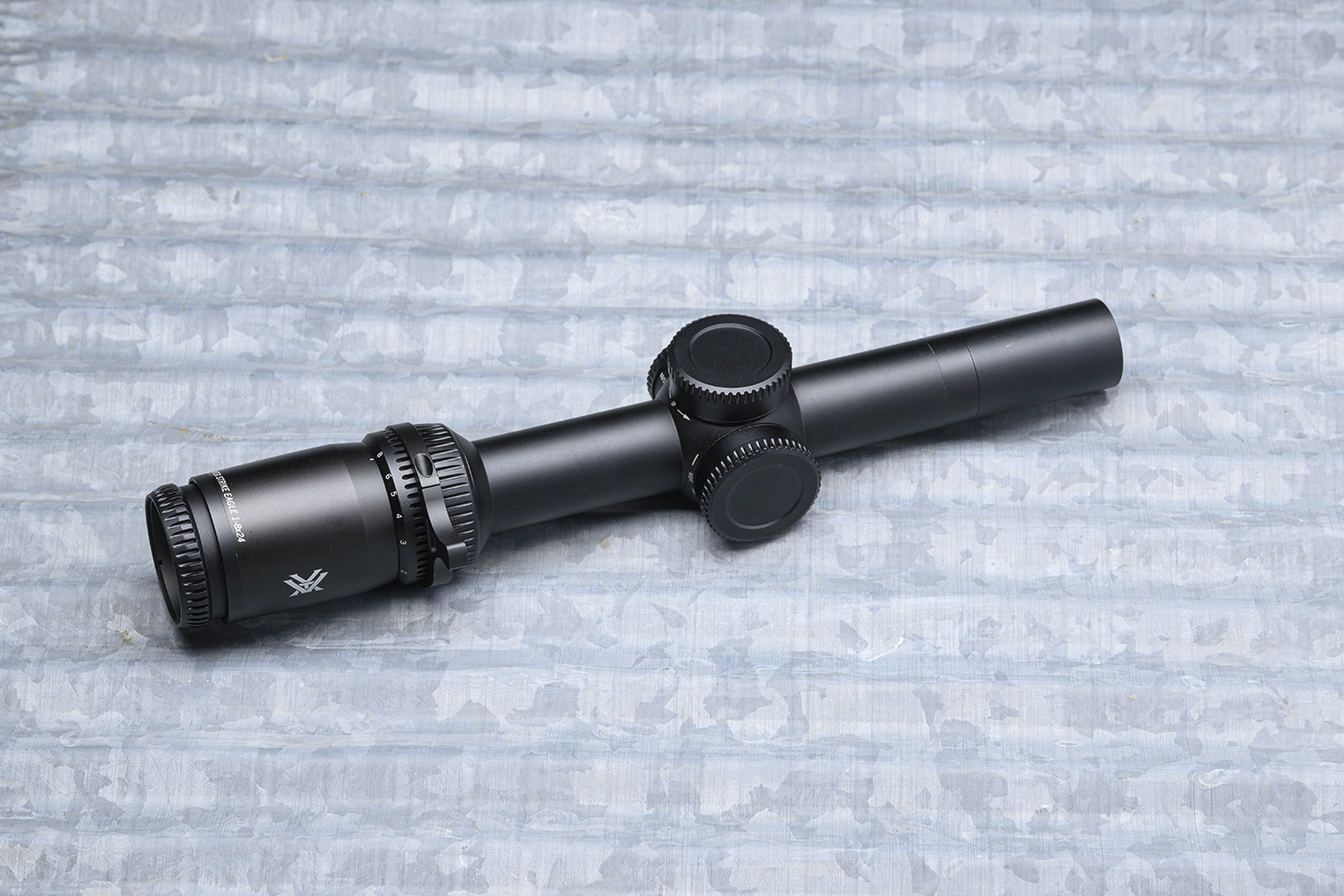
The illumination in this unit runs the gamut from barely visible to searingly bright, and features two settings for night-vision visibility. Our testing revealed only middling optics, and testers were disappointed in the un-positivity of the turrets. The Strike Eagle is a more accessibly priced LPVO in Vortex’s line than the flagship Razor HD, but given its expansive utility, it’s an excellent optic to swap between many of the rifles in your safe.
Best for Rimfires: Bushnell Trophy Quick Aquisition 1-6×24
Key Features
- Second-plane
- Dot Drop MOA enhanced duplex reticle featuring ½ MOA illuminated center dot and ten holdover hash marks
- Capped turrets with ½ MOA values
- 140 MOA total internal adjustment
- 30mm tube
- Six illumination intensities
Pros
- Liberal mounting dimensions
- Reticle suited for rimfire hunting
- Accessibly priced
Cons
- Noticeable peripheral distortion
- Limited field of view compared to peers
- Reticle has limited utility

After our optical testing exercises, I strapped this scope to a semi-auto Bergara .22 and took it rabbit hunting. Its performance as a fast, simple, lightweight optic for the field more than made up for its shortcomings on our evaluation line. In that testing capacity, we dinged its dim glass and optical aberrations, and we wanted more reticle references. But in the field, the fine center dot showed up against every background, and the scope enabled both-eyes-open dynamic shooting that delivered a sight picture more like a shotgun than a rifle. This is a scope that will improve just about every .22 on the market, and a not-insignificant number of turkey and lever guns, as well.
Best Tactical: EOTech Vudu 1-10×28
Key Features
- 34mm tube with sunshade
- 10-step illumination
- Pull-to-turn exposed elevation turret, capped windage turret, both tuned to .1 MRAD click values
- 29 MRAD total elevation adjustment
- First focal plane
- LE-5 reticle with speed ring featuring inner-circle crosshair and 12 MILs of holdover and windage
Pros
- Dual-service reticle is extremely versatile
- Excellent glass and coatings
- True 1-power has immense field of view
- Push-button illumination is fast and intuitive
- Throw lever enables fast power changing
Cons
- Most expensive LPVO in the class
- Elevation turret locking ring can get jammed with debris

Competitors would be wise to look at the attributes of this LPVO as they design new optics. While there are some drawbacks to this marvelous scope—among them is its high price and its exposed turret—the versatility of the first-plane reticle elevates the EOTech to the stratosphere. The reticle essentially provides shooters with three very different sight pictures.

At its lower powers, from about 1-4x, the speed ring acts as a fast-acquisition red dot, and it’s here where the blazing-bright illumination makes this the best close-quarters battle scope in our test.
At middle powers, from about 5-7x, the outer ring disappears and the reticle’s precision reference becomes visible while shooters still have a wonderful field of view.
At its highest powers, 7-10x, the reticle’s hold references take over, and allow for very precise bullet placement out to 500 yards and farther.
Our sample has the LE-5 MRAD reticle, which has a cross-aiming point. I might consider the SR-5 reticle for its .25 MIL center dot inside a 2 MRAD circle. The reticle is also available with MOA references.
Best for Hunting the Big Woods: Leupold Patrol 6HD 1-6×24
Key Features
- 30mm tube
- Push-button FireDot illumination
- Duplex reticle in the second focal plane with illuminated center dot
- Capped turrets tuned to .25 MOA click values; 20 MOA per revolution
- 170 MOA total elevation adjustment
- Available with illuminated CM-R with center dot and holdover references out to 800 yards
Pros
- Center-dot illumination makes the aiming point pop in low light
- Versatile duplex reticle suitable for use on guns for turkeys, bears, dangerous game, and other close-in quarry; the CM-R is the better precision reticle
- Liberal mounting dimensions
- At only 16.2 ounces, one of the lightest LPVOs in the group
Cons
- Duplex reticle has limited long-range utility
- Pricey considering limited attributes
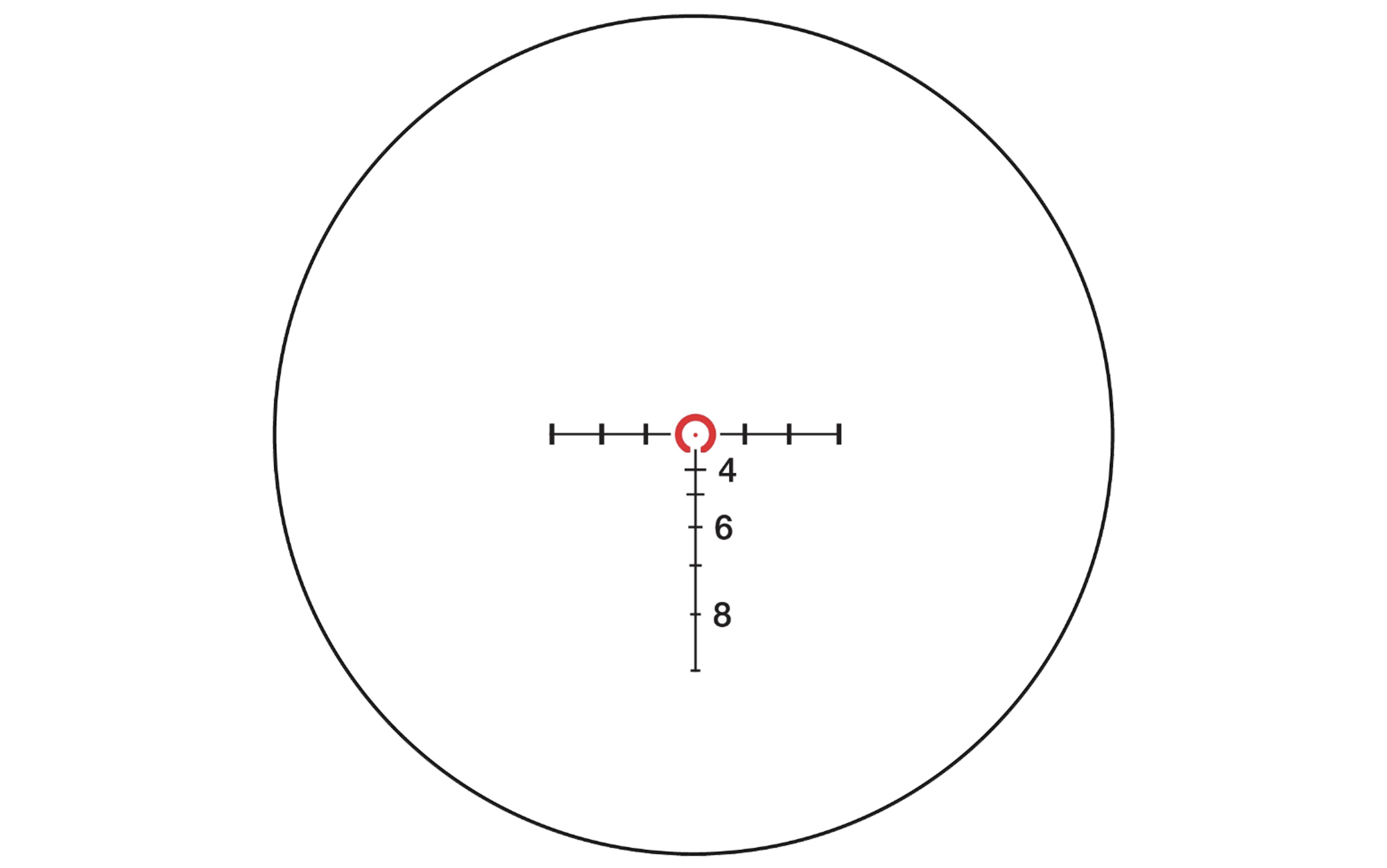
A bare-bones LPVO, this simple, versatile scope is at home on just about any firearm, but is very well suited for close- to mid-range hunting in low light situations. Bear hunting comes to mind, or maybe a short- to mid-range deer rifle. The Patrol 6HD has among the most liberal mounting dimensions in the LPVO class, and its sub-pound weight makes it a great mate with light rifles.

Our sample has a simple duplex reticle with a 1 MOA illuminated center aiming point, but Leupold’s CM-R reticle is a better option for shooters who want more references. Both second-plane reticles are illuminated by the push-button FireDot illumination feature. The Patrol 6HD is also compatible with Leupold’s custom turret dial system, so you can customize the optic’s bullet drop controls to your specific load.
Best Precision: Primary Arms PLx 1-8×24
Key Features
- 30mm tube
- First-plane illuminated ACSS Raptor M8 reticle with center chevron, inverted horseshoe, and holdover/windage dots to 800 yards
- Exposed elevation turret, capped windage turret, both tuned to .1 MIL click values
- Ships with additional capped elevation turret
- 100 MOA (29.1 MIL) elevation adjustment range
- ACCS (Advanced Combined Sighting System) high-precision reticle includes moving-target leads, ranging stadia, and extremely fast and precise interior chevron
Pros
- Excellent glass and coatings
- True 1x provides a tremendous field of view
- 10-step illumination is night-vision compatible
- Ambidextrous dovetail throw lever makes power changing fast
- Weighs just under 17 ounces
Cons
- Fairly shooting-specific reticle design
- Stingy mounting dimensions
- Fairly pricey optic
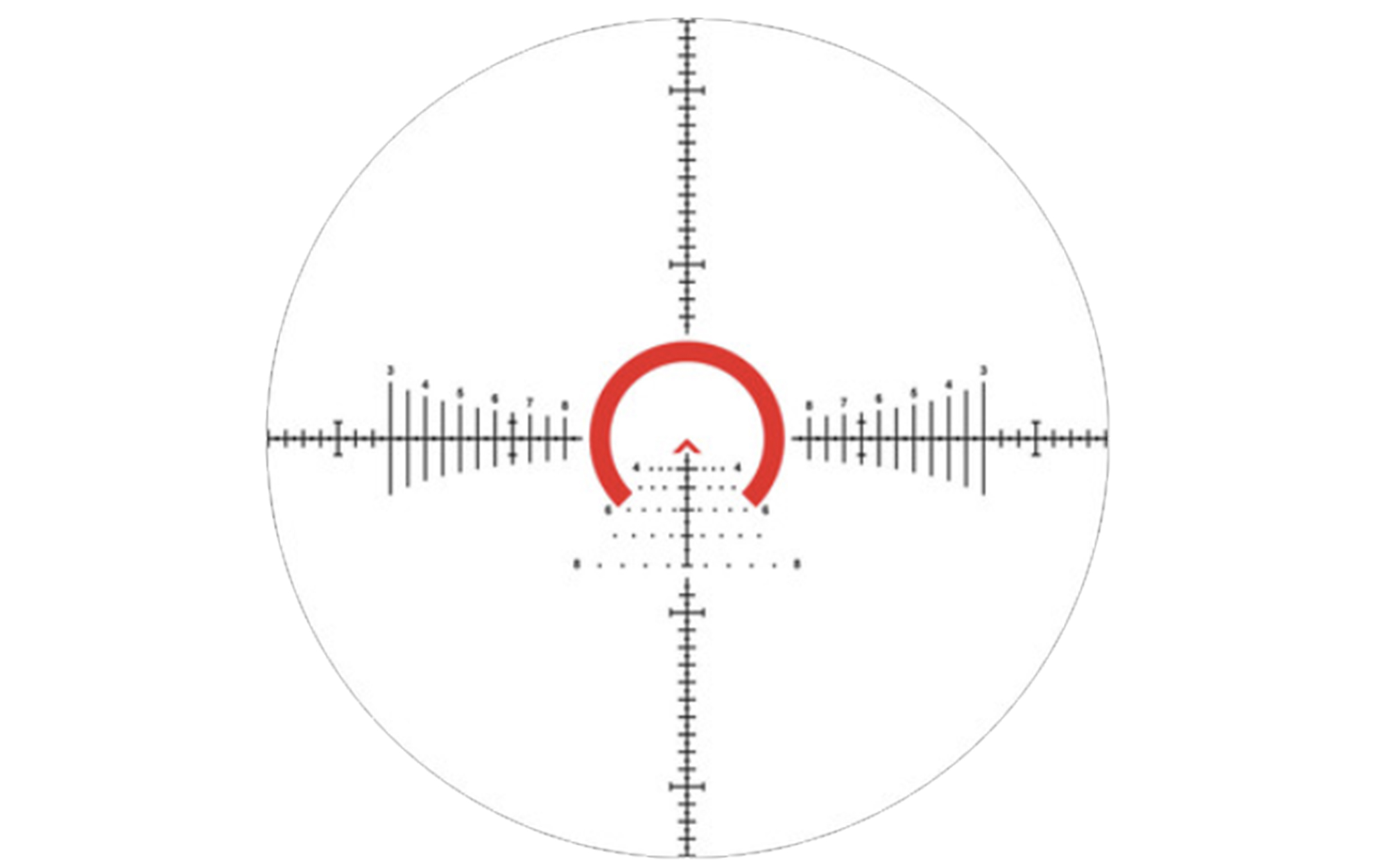
The heart of this marvelous little scope is Primary Arms’ proprietary ACSS Raptor reticle. If you’re looking for a first-plane reticle that can do just about anything, then this design is worth consideration. Designed by master reticle architect Dimitri Mikroulis, the ACCS combines bullet-drop compensation with a fast-acquisition chevron, ranging features, and moving-target references.
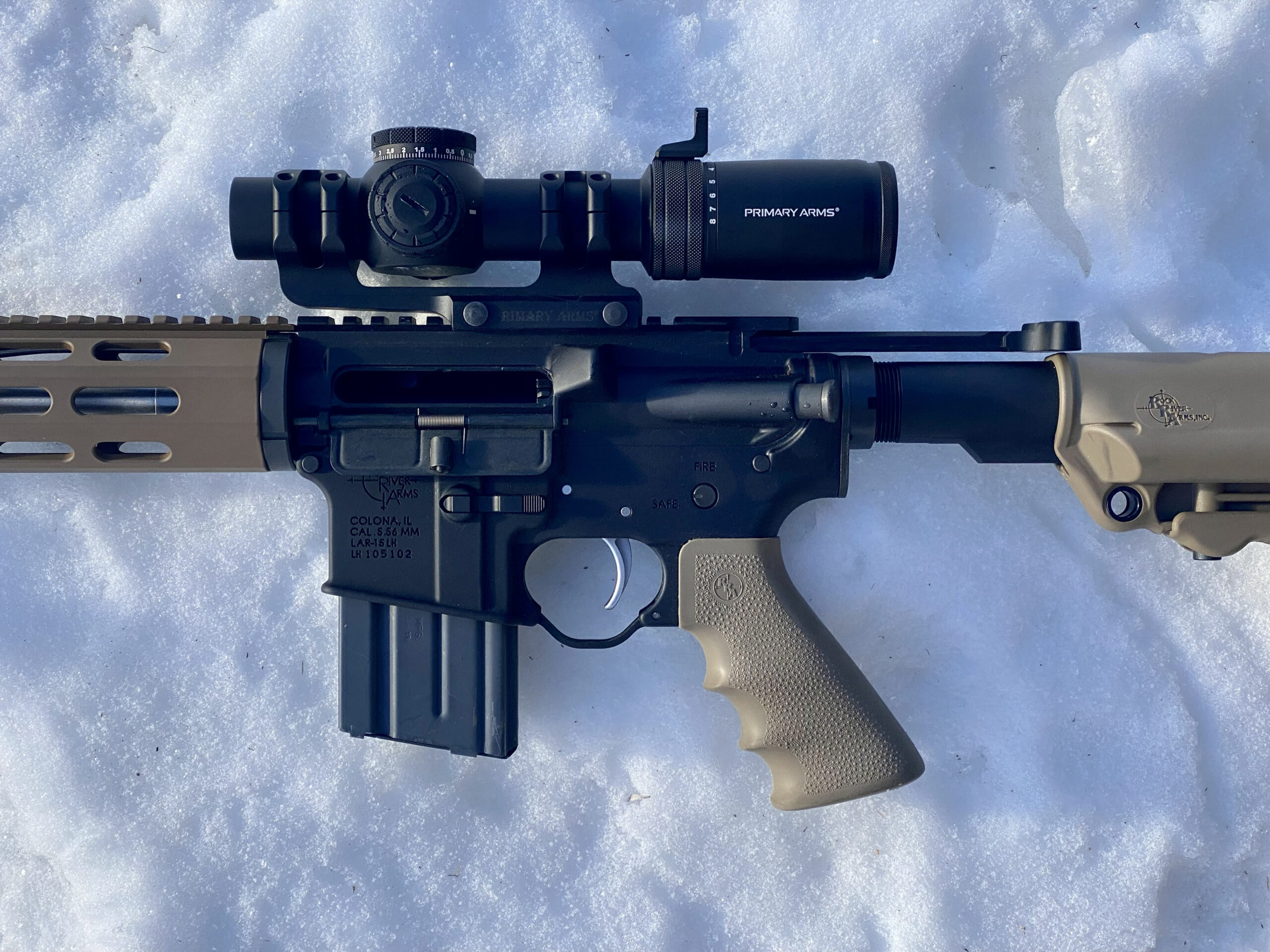
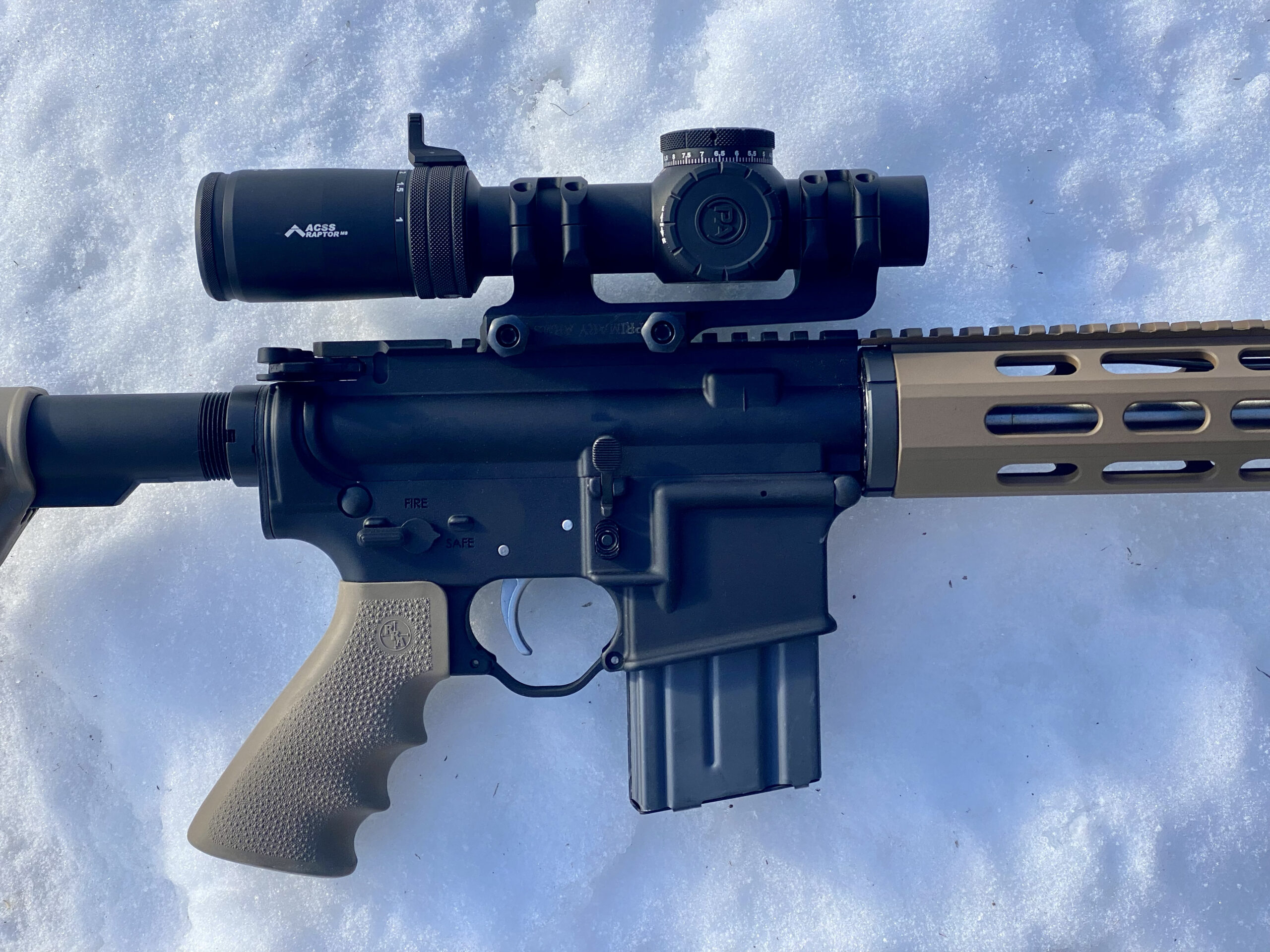
But those attributes don’t really show up in the scope until about 6-power. At lower magnifications, the illuminated aiming point is set off in a German 4 duplex that guides your eye to the center of the reticle. The sweet spot of the reticle is from 4-6x, when the holdover references are plainly visible, but shooters still have a wide field of view and enough stadia references to place bullets at middling distances.
Best Designated Marksman Scope: Trijicon Credo HX 1-8×28
Key Features
- 34mm tube
- Pull-to-turn exposed turrets tuned to .25 MOA
- First plane illuminated reticle with segmented circle and center cross aiming point and holdover hashes out to 100 MOA
- 10-step red and green illumination
Pros
- Best glass in the class
- Quick target acquisition reticle with plenty of references for long-range precision work
- Red and green illumination
- Excellent turret positivity
- Repositionable magnification throw lever
Cons
- Illumination of holdover hashes is dodgy
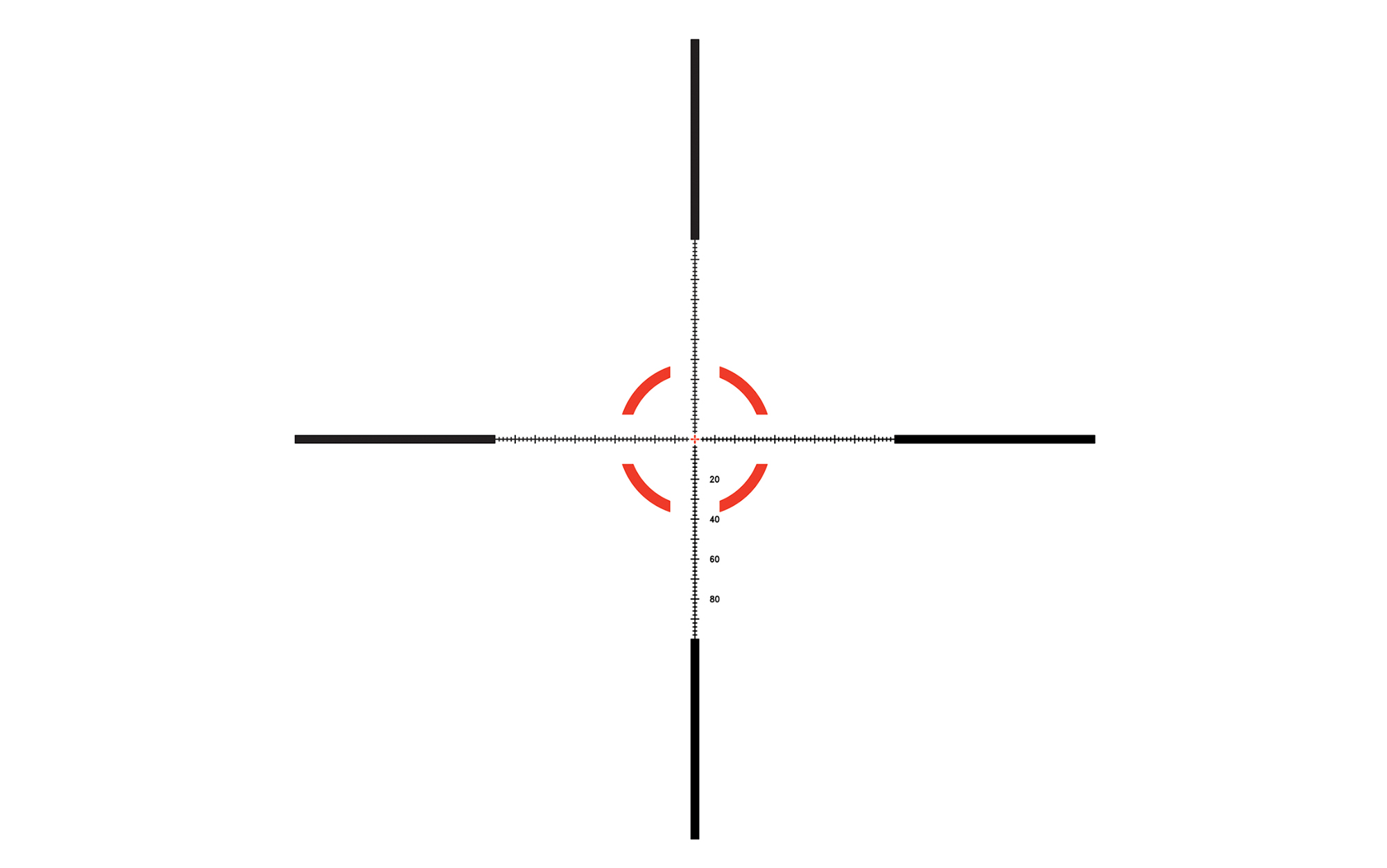
Like the EOTech and Primary Arms LPVOs, this scope from Trijicon is built around a double-duty first-plane reticle, but unlike the first two, the precision references are standard stadia hashes tuned to .1 MIL or 1 MOA steps, depending on your model.
The result is a very fast close-quarters scope with equally fast action at middle distances. The Credo HX might not have the specific reticle holds for, say, a 5.56 at 400 yards, but you don’t have to count holdover dots in order to place a long shot with decent precision. The turret positivity is among the best of any LPVO we’ve tested, and the slight flare on the objective bell provides a nice shoulder for rings. The Trijicon turned in the best low-light score of the entire field. This would make a great Designated Marksman scope.
Best for Dangerous Game: Tract ToricUHD 1-8×24
Key Features
- 30mm tube
- Available in either MOA or MRAD versions
- Capped and re-zeroable turrets tuned to either ½ MOA or .2 MRAD click values
- Hash-style reticle in second focal plane with illuminated center aiming point
- 10-step illumination
Pros
- Recoil tested to endure heavy-recoiling firearms
- Nearly 7 inches of mounting space on main tube
- Excellent glass and coatings
- Clean reticle design does not obscure image
- Graphite finish is sharp and scratch-resisting
Cons
- Illumination is underwhelming
- Turret click values are course for long-distance precision work

The first attribute you notice on this stylish graphite-gray scope is the image. It’s bright and stunningly wide, features that make it an excellent hunting scope. Add velvety power-changing controls and extremely tactile turret turns, and the ToricUHD feels like a precision instrument. The second-plane reticle is a little underwhelming. It’s a standard hash-style with a fine illuminated center aiming point inside a modified German 4 duplex. The simplicity is an attribute, though, because it allows for fast target acquisition with just enough references to make holdover adjustments.
Testers felt the Tract would be at home on a turkey shotgun, crossbow, or straight-wall carbine, but especially a big-bore rifle where an obvious aiming point and clear optics are minimum requirements for what can be fast shooting. The Toric was runner up in both optical resolution and low-light scoring.
Best Value: Sig Sauer TANGO-MSR 1-10×28
Key Features
- 34mm tube
- Second-plane illuminated BOC10 reticle with dot center point, open circle, and tree-style BDC windage and elevation references
- Capped turrets tuned to ½ MOA click values
- 11-step illumination
- 100 MOA windage and elevation adjustment range
Pros
- One of the most affordable LPVOs in the group
- Ships with 34mm cantilevered unimount
- Reticle balances between short-range quick-acquisition design with decent precision references
- Available in either black or coyote tan
- Throw lever makes power changing a cinch
Cons
- Noticeable peripheral distortion
- Holdover references hard to see against cluttered or dark background

Sig Sauer has no shortage of LPVOs in its lineup, and the original TANGO6 has been adopted by the U.S. Army as its carbine-mounted LPVO. But this iteration of the TANGO is priced to be accessible to most recreational shooters. Look for sales, but it should be available for around $500, and that includes a 34mm unimount. The second-plane reticle has the usual bright center-aiming architecture and a decent amount of bullet-drop compensating references. The glass is only okay. But if you’re going to get just one LPVO that’s optimized for AR platforms, this is a pretty good choice.
Best Under $300: Riton 3 Tactix 1-8×24
Key Features
- 30mm tube
- Capped, re-zeroable turrets tuned to ½ MOA click values
- Fully illuminated OT dot/circle/hash reticle in second focal plane
- 11-step red illumination
Pros
- One of the most affordable LPVOs in this class
- Available in either black or flat dark earth finish
- Power change throw lever included
- Reticle is fast and clean
Cons
- Underwhelming glass
- Turrets hard to turn
- Hash-style reticle isn’t conducive to long-range precision work

This is sort of a derivative LPVO, but it’s fully capable of running an AR at close quarters or out to middle distances, and it’s such a bargain that you might think of buying two. The glass is disappointing, and the reticle, a floating dot/circle arrangement with hash holds on the main stadia, is not quite as versatile as some in the class. But the controls are good and the price is right.
Other Great LPVOs
Vortex Razor HD GenII-E 1-6×24
Key Features
- 30mm tube
- Capped, low-profile turrets
- Second-plane illuminated reticle with center aiming dot and 35 MOA of holdover references
- 11-step red illumination
Pros
- Best glass in the class
- Quick target acquisition reticle with plenty of references for long-range precision work
- Brilliant illumination
- True 1x magnification
- Huge 4-inch eye relief across magnification
Cons
- One of the most expensive LPVOs on the market
- Range limited by 6x
One of the classics in the LPVO field, this little marvel has some of the best glass in the class and is built for fast-fire situations on an AR but surprisingly precise shooting on just about any firearm platform. Note the E after the name; this “Enhanced” model of the Razor HD is a quarter-pound lighter than earlier versions and has slightly more positive turret controls.
The rest of the model remains the same: excellent Japanese glass, picture-window field of view at lower powers, a fine ½ MOA center dot, and just enough holdover steps to provide references without cluttering the image. The scope is available in MRAD or MOA configurations.
Nightforce NX8 1-8×24 F1
Key Features
- 30mm tube
- Exposed turrets tuned to either ½ MOA or .2 Mil-Radian click values
- First plane illuminated reticle with center cross inside segmented circle and holdover hashes out to 20 MIL or 60 MOA
- 10-step red illumination
Pros
- Best glass in the class
- Quick target acquisition reticle with adequate references for long-range precision work
- Forgiving 3.7-inch eye relief
- Most tactile turrets in the LPVO class
- Magnification throw lever
Cons
A battle-tested low-mag workhorse, this scope combines excellent glass, the most durable controls in the industry, and a practical reticle (available in either MOA or Mils) that covers firing solutions from the ultra-close to the middle distances. The turrets, with Nightforce’s patented ZeroStop, make quick returns to zero after dialing an aiming solution quickly and positively. It’s also 3.4 ounces lighter and $1,000 cheaper than it’s more robust brother, the ATACR 1-8.
Hawke Vantage 30 WA 1-8×24
Key Features
- 30mm tube
- Capped low-profile turrets tuned to ½ MOA click values
- 210 MOA total internal adjustment
- Classic L4 duplex dot reticle powered by new “Fiber Dot” illumination with 11 intensity levels
- Ships with integral power-changing lever
Pros
- Weighs only 16.5 ounces
- Suitable for wide variety of firearms platforms
- Fiber dot illumination provides daylight-bright intensity
Cons
- Simple duplex reticle has limited distance capability
If you haven’t checked out the dizzying number of scope lines and various configurations in Hawke’s lineup, then you are missing a rising player in magnified optics. The company has three new LPVOs on the market this year, but this version—with a new illumination technology—is versatile enough to mate up with a wide range of firearms. The technology harnesses fiber optics to fire the illuminated center dot, allowing for a wider range of brightness and dimness than traditional LED dots. We didn’t test the optical attributes of this new scope, but the duplex reticle is fast and unfussy.
Crimson Trace HardLine 1-10×28
Key Features
- 34mm tube
- Illuminated TR1-MIL reticle in second focal plane
- Reticle features illuminated center-cross aiming point with holdover dots out to 500 yards
- Capped turrets tuned to ½ MOA or .2 MIL click values
Pros
- Big, beefy scope
- Reticle designed for quick acquisition work and a decent amount of medium-distance precision shooting
- Available in either MIL or MOA configurations
Cons
- Illumination limited to center cross
Another new-for-the-year LPVO, this is a big 34mm model that offers a floating reticle with decent close-in, quick-acquisition attributes, and limited holdover references. I’ve inspected one of these, and it was under the life-sucking lights of the SHOT Show in Vegas, so I can’t comment on the low-light performance or optical resolution of the scope. But, the controls are tactile and tight, and the 1-10x magnification range gives the new HardLine plenty of versatility.
GPO Spectra 6x 1.5-9×44
Key Features
- 30mm tube
- Illuminated G4 duplex or G4Drop reticle with center aiming dot in second focal plane
- Capped turrets tuned to 1cm at 100 meters click values
- Red illuminations shuts off after 3 hours
- Only LPVO in this class with objective lens swell, owing to 44mm objective lens
Pros
- At only 20 ounces, fairly lightweight
- Drop version of the duplex reticle has holdover references
- Optical fiber technology enables illuminated dot to get daylight bright or muted for low-light conditions
Cons
- More of a big-game scope than an AR-type LPVO
The first thing you’ll notice is that this isn’t configured as a standard LPVO, with a straight tube. Instead, its exterior lines resemble a standard riflescope. It’s GPO’s latest low-power offering, and it’s a great fit for just about any rifle, from a lightweight mountain rig to a new straight-wall carbine. The Spectra comes in two reticle configurations, either a standard G4 duplex or the G4 with a few bullet-drop references on the vertical stadia. The glass appears to be bright, and the 44mm objective should make it a standout low-light performer compared with the standard 24 to 28mm objectives of the LPVO class.
Schmidt and Bender PM II ShortDot Dual CC 1-8×24
Key Features
- 30mm tube
- Illuminated red-dot second-plane reticle combined with first-plane tactical reticle
- Capped turrets tuned to 1cm at 100 meters click values
- Red illuminations shuts off after 3 hours
- Designed for close-combat engagement
Pros
- Advanced reticle design
- Useful for quick target acquisition at close quarters and precision work at mid distances
Cons
- Wildly expensive
- Fairly narrow application
I’m trying to get my hands on one of these sports cars to put its capabilities through my optics test. Unfortunately, I’ve seen only a display model, but the dual-purpose reticle is a marvel of second-plane technology. The idea is that at lower powers, the center aiming point allows for fast firing in low-light situations, but at higher magnifications, the holdover and holdoff references enable slow-fire precision. It’s hard to talk about this close-quarters combat scope, though, without mentioning its price, which is well over $5,000. I have to think some of that stratospheric price is justified by the best-in-class glass, but I haven’t had a sample out in the field to confirm that hunch.
What Is an LPVO?
When we talk about LPVO riflescopes, we’re talking about a category of low-magnification optics that share these attributes: They’re generally 1-power up to 6-power, 8-power, or even 10-power. They typically have straight tubes that allow for low-profile mounting. Most have illuminated reticles that feature a bright aiming point at lower magnifications but which also have elevation and windage references that allow shooters to either hold or dial a firing solution. Most have either capped or pull-to-turn exposed turrets, an indication that these are intended for holding for shooting solutions, not necessarily dialing. That makes sense, since the best of these reticles enable quick shooting with smart and useful references for making both windage and elevation adjustments on the fly.
Those reticles are worth special mention. Some, like EOTech’s marvelous Vudu, feature first-plane reticles that zoom in size and complexity as magnification increases. Others, like the BOC10 in the capable Sig Sauer TANGO-MSR, are second-plane reticles with partial illumination.
Choosing the Best Low-Power Variable Riflescope
The big question to ask as you peruse the wide variety of LPVOs on the market is which one is right for your particular firearm and shooting requirement. The category in general matches well with AR platforms. Their smaller objective lenses allow for low-profile mounting, and nearly all these scopes work well with cantilevered unimounts or base-and-ring sets that are easy to swap between guns with integral rails.
Adding to the AR synergy, the versatile reticles in this class enable everything from close-quarters personal defense situations to longer-distance target work. Beyond ARs, these scopes easily mount on a turkey gun or a straight-wall carbine, a hunting handgun, or even a big-bore rifle that you might use for bears and buffalo.
Nearly all these optics have illuminated reticles, and given the point-and-shoot capability of these scopes at their lower magnification, I’d consider that a minimum requirement for the class. Some scopes have only center-dot illumination; others have inverse horseshoes or circle-dot reticles that light up with various intensities of illumination. I’m a fan of daylight-bright illumination that enables quick shooting in a wide variety of backgrounds and light conditions, but I also want illumination that dims down to a barely perceptible aiming point in low-light conditions.
Another attribute to consider is magnification range. The best first-plane reticles have a magnification range in the 1-8-power or 1-10-power. The wide range gives the fullest expression of the reticle, which enlarges with magnification. Also, consider whether you need capped or exposed turrets. Generally the exposed tactical-style turrets are for shooters who intend to dial, rather than hold, for distant targets.
Consider the reticle. Some are simple duplex crosshairs in the second focal plane, others are complicated first-plane MIL-based holdover designs, and still others have versatile hash reticles that can be tuned to your bullet’s velocity and flight characteristics.
Lastly, consider price. Some of these cost well over $1,000 (actually, closer to $2,000), which seems steep for the amount of glass you’re buying. Others clock in closer to $200. Happily, many are in the meaty middle of the price continuum, running around $500 at retail.
FAQs
Q: What LPVO does the army use?
The various branches of the U.S. military haven’t fully embraced the LPVO as an all-around optic platform. The military generally uses either compact red-dot sights, sub-compact reflex sights, or more sophisticated aiming instruments that are tied into night-vision gear. But the U.S. Army entered the LPVO market when it replaced the rugged and compact Aimpoint with the Sig Sauer TANGO6T. That’s a 1-6×24 scope that features a first-plane reticle in either a 5.56/7.62 version with a horseshoe doe, or the 762 extended range with plenty of holdover and windage references, or the DWLR6 reticle that has holdovers out to 1,000 yards. All the TANGO6T scopes have turrets and reticles tuned to MIL references.
Q: What power LPVO is best?
The best all-around power range for a low-power variable optic is 1-8-power. Nearly all LPVOs bottom out at 1-power, but that lowest magnification isn’t all the same. We measured a number of units in our test and found that about half have low power at about 1.15 to 1.2x. At their lowest powers, between 1x and about 4x, the illuminated reticles (at least those in the first focal plane) act like red-dot sights, enabling quick target acquisition in low light situations. But at the higher powers, from about 5-8x, the reticle enlarges to reveal holdover and holdoff references, enabling slower, more deliberate aiming out to middle to long distances.
Q: Who makes the best LPVO?
The best brand for LPVOs is tough to pick, largely because with this category, the more you pay, the more you get. But the two that have the best balance of affordability and attributes are the EOTech Vudu and the Sig Sauer TANGO-MSR. The Vudu has one of the most useful reticles in our test, a first-plane marvel that acts as a fast, bright aiming point at lower powers but expands to reveal beautifully spaced and arranged elevation and windage references from about 7-10x. The TANGO-MSR is limited by its second-plane reticle, but at lower powers, the eye is guided by bold posts to the very center of the illuminated circle. At higher magnifications, a tree-style precision reticle allows for slow-fire precision. Both are battle-tested, responsive scopes that are perfect for AR platforms but which will make great optics for a wide variety of firearms platforms.
Why Trust Outdoor Life?
Since 1898, OL has been a leading authority in testing and reviewing hunting gear, fishing tackle, guns and shooting equipment, and much more. We have more than a century-long history of evaluating products, and we’re now bringing that expertise to online reviews. Our editors are experienced outdoorsmen and women, and most importantly, we’re trained journalists. We prioritize field testing and objective data when reviewing products. We conduct interviews with gear manufacturers and engineers as well as outdoor experts so that our readers have an understanding of how and why a product works—or doesn’t.
Advertising does not influence our gear reviews and it never will. While we always focus our coverage on standout products—because we want our readers to be aware of the latest and greatest gear—we also cover the flaws and quirks of any given product.
Final Thoughts
Just like the top red dots, the best LPVO market is full of great options. To filter through the sea of great options, weigh how you’ll use the scope with your budget. Then make your selection from one of these durable and bright LPVO options.

